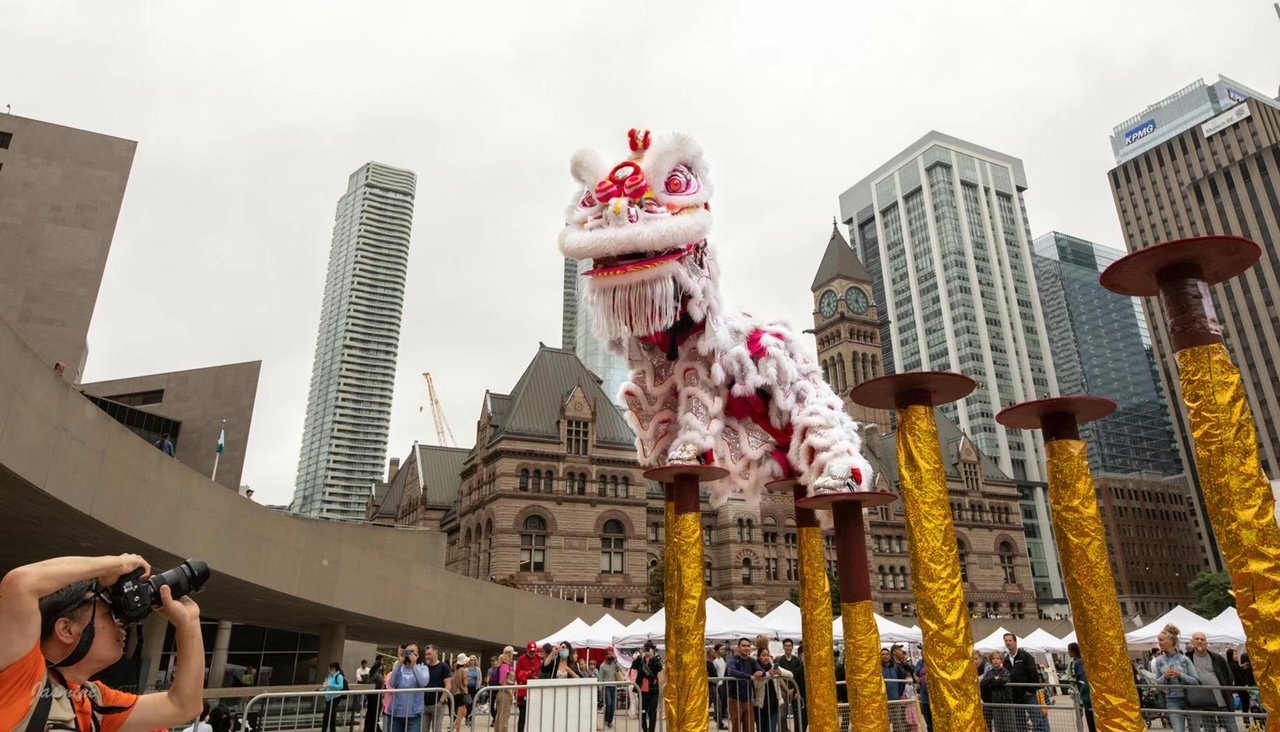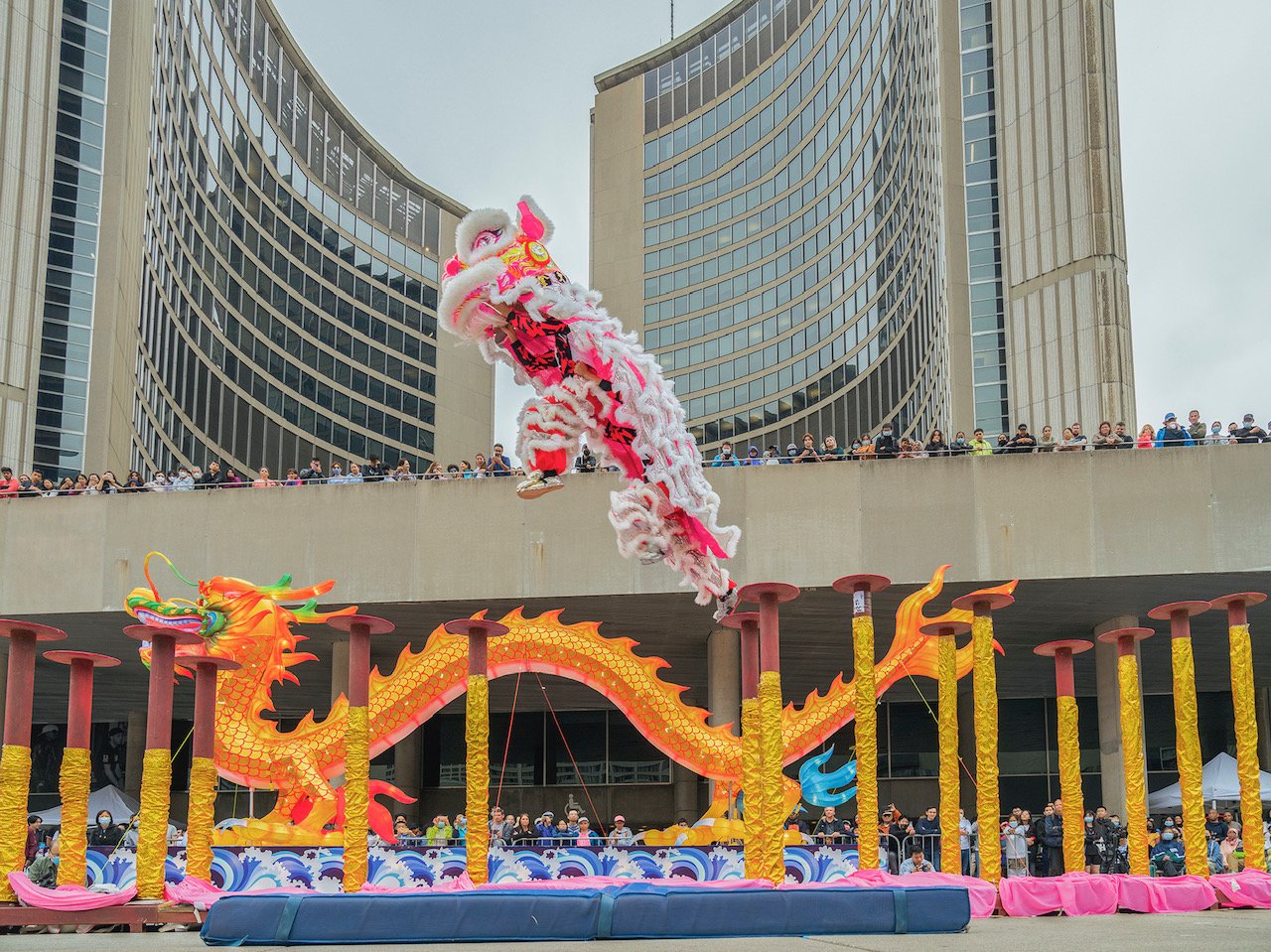In the middle of a ballroom reigns a floor-to-ceiling geometric sculpture that specializes in tricking your eyes. With hypnotizing baritone chants of a sound-healing prayer, resonant gongs chiming in periodically and fog gracefully waltzing on the dancefloor, a mesmerizing light show comprised of neon lasers and patterned projections is displayed on this angular goliath. With the sculpture accompanied by a black backdrop, the wires supporting it are swallowed into the darkness; it seemingly and effortlessly balances the point of its kite-shaped body on the tip of its pyramid-like base.
As the rainbow of lights gracefully moves across the sculpture, revealing new kaleidoscopic designs every few seconds, it constructs manufactured shadows and falsified depth. It is a thousand sculptures in one. The countless colours displayed among the ever-changing patterns are tattooed onto the backs of your eyelids — the odd, mind-bending shape of the structure keeps the tie-dye of welded optical illusions contained within your mind.
This nine-minute light show, created by California artist GMUNK and displayed at The Psychedelics Show: The Experiential Exhibition in Toronto from September to December 2022, offers a small insight into the experience of an ayahuasca trip. GMUNK, an enigmatic creative who spent much of his childhood with the Lakota Sioux Tribe in South Dakota, used his past experience with both psychedelics and light work to create the grand finale of the exhibition.
When his parents divorced and his mother joined the Lakota Sioux Tribe when he was 10-years-old, GMUNK became immersed in Indigenous culture. The artist said that the tribe’s ability to live off the earth through their deep respect for all living creatures guided him to explore further into psychedelic ceremonies — namely, ayahuasca ceremonies — to connect further with the world around him, but to connect with himself.
While the exhibition's finale is officially untitled, he calls it the Totem.
“It's kind of like a spiritual monument that takes the audience through a nine-minute ceremony of healing through sound and light and movement,” explained GMUNK. “It’s a journey … It's a whole prayer with meaning.”
Even before deciding on a theme for the show, executive producer and creative director Jamie Drayton knew that he wanted to centre it on an issue that had substantial cultural relevance — and he wanted to do that through art.
That’s exactly what arts-based research (ABR) is: the effort to expand knowledge and educate a broader community through a medium that everyone can understand. By using art as a learning tool, it invites a collective understanding of topics that would otherwise go unrecognized.
“Visual arts-based practices are necessarily participatory — that is, visual art has an audience that experiences it,” ABR expert and author Dr. Patricia Leavy explains in her book Method Meets Art: Arts-Based Research Practice. Aside from visual arts, Leavy explains that ABR can take many forms, including theatre, film, storytelling, music and dance, among others.
Aside from the Totem, The Psychedelics Show offers an immersive experience of the historical and scientific nuances of the drug. From hallucination simulations to gigantic mushroom landscapes to captivating paintings to a rotating list of live performances, this exhibition came together with the help of around 30 artists in order to help de-stigmatize psychedelics.
When applied to the world of psychedelics, ABR is a natural conductor for encouraging conversations about the substance, but using this form of education has only been possible in recent years.
Since academic and scientific research on the drug has been thoroughly swept under the rug since its criminalization in the 1960s, the negative stigma surrounding it has held a strong grip on the public. As long as the public continues to remain uninformed about the potential mental health benefits psychedelics present, those stigmas will continue to remain prevalent.
Fortunately, academic research on the topic has experienced a resurgence in the 21st century, with exploration spiking significantly in the past decade, according to an article from Frontiers in Psychology.
Along with this research, it has been repeatedly shown that controlled and monitored use of psychedelics, specifically psilocybin, LSD, ketamine, ayahuasca and others, has helped with PTSD, anxiety, depression, substance use disorders, end-of-life distress and chronic pain, according to a comprehensive 2022 report on psychedelic medicine by Queen’s University.
While this expansion has started to dissolve the stigmas, the recent psychedelic research has been kept in a strict, industry-contained bubble.
“A lot of the good work being done is really in a psychedelics industry,” noted Drayton. “There’s a lot of companies and not-for-profits doing the research … but it’s still very much isolated to an industry.”
That is where ABR comes in.
ABR goes beyond the structured academic realm and invites the masses to not only learn about the topic in a malleable, formidable way, but also in a participatory and inclusive way.
“In many ways, the arts can go to people and be a part of their everyday life, so they can reach people where they're at,” explained Rita Irwin, a distinguished university scholar and professor of art education and curriculum studies at the University of British Columbia.
“We've created an experience here that people come and find interesting and entertaining and amazing and inspiring,” said Drayton. “We facilitate conversation around the topics that still so many people [stigmatize].”
Ted Wallace, an acrylic artist based in British Columbia and one of the contributors to the exhibition, was elated to join the efforts to de-stigmatize psychedelics. The 74-year-old retired teacher and self-proclaimed hippie has spent most of his life on a spiritual journey, constantly challenging himself to find new meanings within his life through mindfulness and meditation. He said when he started this journey back in the early-’70s, psychedelics had a significant role in it and allowed him to alter his worldviews.
“The world as we see it is very subjective,” said Wallace. “You can change your view and see a whole different world … and psychedelics showed me that that was possible.“
Wallace’s past experiences with psychedelics still impact his choices today, and it’s evident through his art. He finds it difficult to place labels on his work, and despite many art exhibits calling them psychedelic or intuitive, Wallace believes his pieces live outside the box and within an inner vision.
“I'm always looking not to express the static but to express the movement, and that often involves a periphery vision — what is unseen,” explained Wallace. “I try to paint the underneath and that's how I feel the subconscious translates for me.”
One of his pieces displayed at The Psychedelics Show, a colourful abstract that takes on an otherworldly presence, is part of Wallace’s Ascension Series. If you quickly glance at it, you might mistake his acrylic work for stained glass, as the countless colours flow in smooth, solid and sectioned lines. It reflects the energy and visions of an “explosion or expansion from the heart and from the mind” that Wallace had at the time of creation.
But while he devotes countless hours to each of his paintings, he says that he wants the viewer to get more out of his work than he does. “I have an idea, I have a story, but your story is the one that counts,” said Wallace.
Wallace also hopes that his art helps to bring people together on a journey of enlightenment.
While Wallace isn’t able to visit the exhibition from B.C. and see the impact his work is having, Drayton testifies, saying that one of his favourite things to come out of his exhibition is seeing strangers standing next to each other, conversing and having a shared experience. Drayton says he can see people actively shifting their perspective on psychedelics as they take in the art. Witnessing this vulnerability between strangers is a testament to the active work that ABR projects like The Psychedelics Show is doing.
Leavy’s book elaborates on the potential that ABR can have on controversial topics. “Visual art and imagery can inspire both social and self-reflection, quite actually prompting us to see differently,” Leavy writes.
Along with the progress that Drayton’s show is making to promote de-stigmatization, his work is not the only piece of psychedelic ABR that’s making an impact.
Cory Firth is the chief storyteller at the Nikean Foundation, a charity that has a long history of promoting and conducting research on psychedelics as a form of medicine for mental health. Recently, Firth and the rest of the Nikean team have realized that academic and scientific research is often inaccessible to the general public, prohibiting their efforts from leaving the confined psychedelics industry.
In an effort to expand their outreach, Firth decided to dive into the art of storytelling.
With their new framework, the Nikean Foundation collects stories from people across Canada who have been significantly impacted by psychedelics in an effort to merge research with personal experiences. By taking this human-centric approach and allowing people to tell their own stories, it allows for a broader understanding of the impacts plant-based medicine has on individuals.
“Data means science, but story means culture,” explained Firth.
From finding profound healing after a chronic diagnosis to walking down a path of eating disorder recovery to overcoming combat PTSD, these stories are intensely vulnerable and personal to each individual. By enlightening the public on the benefits that psychedelic medicine can offer through real people’s stories, rather than through another set of statistics, it creates an empathetic human connection.
“It's really about making education actionable,” Firth said. “It's not just about lecturing or spitting out data and facts — it's about really getting to the emotional trigger within each individual and inspiring permission to take an action towards the betterment of their well being.”
The Nikean Foundation launched its storytelling platform in September with almost 40 videos of individuals sharing their experience first-hand. Firth said they have another 100 hours of stories in the bank.
Allowing the public to share their own experiences and participate in the educational exposure of research is an aspect of ABR that is rarely found in any other research method.
“Oftentimes, [ABR] can have a very therapeutic effect on the individual by just telling their story,” noted Irwin, “but then others, they'll hear the story and they learn from the story … it becomes a much more human and real encounter.”
But when telling these stories — when inviting the world to learn about psychedelics — it’s important to address and wholeheartedly acknowledge the Indigenous origins of the drug. While the mainstream, colonial world is experiencing a psychedelic renaissance, there is a major risk of this Indigenous relevance being ignored and buried completely, according to a 2021 report in the International Journal of Qualitative Studies in Education.

































































